We’ve been busy recently at Newquay Zoo setting up for some primary school workshops about wartime life and what happened in zoos in WW2.
http://www.newquayzoo.org.uk/learning-zone/world-war-zoo
This topic has survived into the new 2013/14 Primary History Curriculum in Year 6 as turning points in history, elsewhere as ‘local history’ and can be seen in the Inspire Curriculum (Cornwall Learning) as Year 6 Spring 2 Unit: The Battle of Britain: Bombs, Battles and Bravery.
A colourful cross-Inspire Curriculum map for this topic can be downloaded via this link.
Schools visit Newquay Zoo from upcountry and around the county for many topics. One recent local school who usually go to a local museum visited to find out the answer to an unusual question. The children asked their teacher – “What happened to animals during the war?” so a trip to Newquay Zoo was the answer. Others book in as the start or finish of their wartime history classroom topic or alongside their more traditional animal studies of rainforest or habitats.
Our wartime zoo trail is quickly set up for visiting schoolchildren around the zoo, a trail that’s been shared with visitors during Armistice weekends and wartime garden weekends.

One of our temporary World War Zoo Gardens trail boards around the zoo set up for schools workshops, World War Zoo Gardens workshop, Newquay Zoo
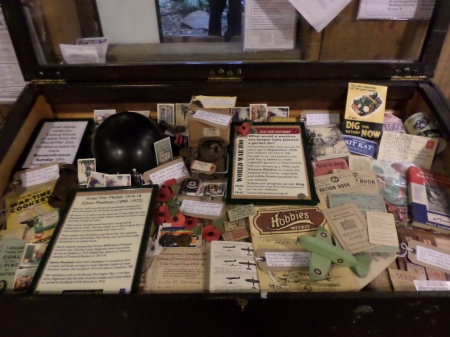
Our display case in the Tropical House houses a changing topical collection of wartime Home Front items from civilian and zoo life from WW1 and WW2. There’s an Eye-Spy list to encourage students to look out for and identify some of the more unusual items. They generate interesting history questions: What are they? Who used them and what were they used for?
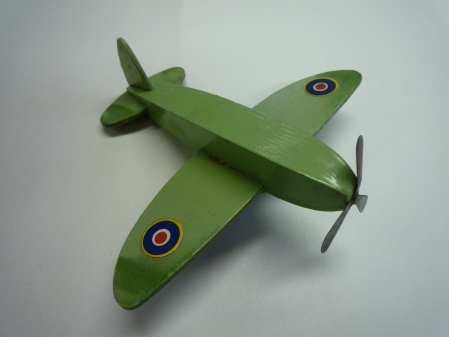
The Battle Of Britain in miniature for a wartime boy! A beautiful wartime handmade wooden Spitfire toy in our display case for the wartime object collection on the BBC A History of The World.
Some of my favourites are the handmade items like toy wooden Spitfires or puzzle games from scrap materials, our contribution featured in the BBC digital online museum accompanying the BBC’s “A History of The World in a Hundred Objects”.
The biggest effort is in unpacking and repacking our stored wartime artifacts. These range from large items like heavy wartime civil defence uniform jackets and land girl overcoats to smaller items like steel helmets that are interesting for students to try on and feel the weight. It’s not advisable to try on the different gas masks though, if they still have the filter sections intact or attached. Many of these are everyday wartime items that zoo keepers, their families or zoo visitors would have carried and been very familiar with.
It takes a while to pin up wartime posters and unpack ‘evacuee’ suitcases but the end result looks good so well worth the effort. Alongside our original Newquay War Weapons Week poster design by evacuee Benenden schoolgirls, the other wartime posters (” weapons on the wall”) are battered old reproduction examples from the Imperial War Museum shop

‘ Evacuee’ suitcases with original handmade wartime toys, ARP advice and blue WAAF silks! World War Zoo Gardens workshop, Newquay Zoo (Picture: Lorraine Reid, Newquay Zoo)
Different topics such as the outbreak of war and closure of places of entertainment like zoos, preparing and repairing the zoo from air raid damage, feeding the animals when they had no ration books and coping with the call up and casualties of staff are covered through enlarged photographs, newspaper headlines, adverts and posters from our collection to illustrate our talk or answer questions.
Through telling the story of how we are researching wartime zoos and showing the students many of these original source materials, we’re showing them an idea of the process of how history is written and researched, an important skill for future historians.

Rationing and Dig For Victory gardening items being laid out for our World War Zoo Gardens schools workshop, Newquay Zoo
(Photo: Lorraine Reid, Newquay Zoo)
The tiniest items on display are original artefacts like shrapnel and incendiary bomb tail fins that did such damage to zoo and botanic garden glass roofs and hay stores. These small items, along with the bewildering variety of wartime cap badges and buttons, often survive as part of a wartime schoolboy’s souvenir collection of relics.
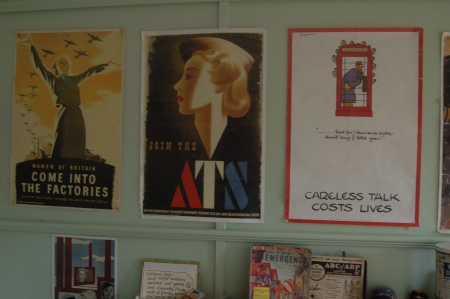
“What did you Do in the War, Granny?” is partly answered by these poster reproductions on the wall. World War Zoo Gardens workshop, Newquay Zoo
This schoolboy collecting bug often puzzles the female students – “what did girls do during the war?” they ask. This question we partly answer with a range of items from land girl greatcoats, women’s magazines, cookery books, knitted dolls and some highly desirable items such as WAAF issue silk stockings and bloomers. Most of the students know how stockings were faked using gravy browning, coffee and eyeliner pencils for the seams. Our other precious silk item, of course of animal origin, is a pilot’s silk escape map of S.E. Asian jungle islands where many of our endangered animals come from today.
We try to cover all the senses such as the weight and roughness of uniforms, sandbags and helmets. Smell is not so easy to represent – what did wartime Britain smell like? – but we visit our recreated wartime allotment near the Lion House to harvest (in season) some fresh animal food and herbs.
Taste is a tricky sense to safely build into a workshop, what with modern concerns over food allergies (did they exist during rationing?) However our fabulous Cafe Lemur staff have in the past helped introduce workshops in the quieter times of the year by cooking up batches of fresh and reasonably edible potato biscuits (recipe below) for students to try, taken from some wartime recipe sheets we have for visitors to take away. It’s always interesting to watch the facial expressions of students as they risk the first bite. Only a few aren’t eaten! (Please note: wartime biscuits not always available in workshops).
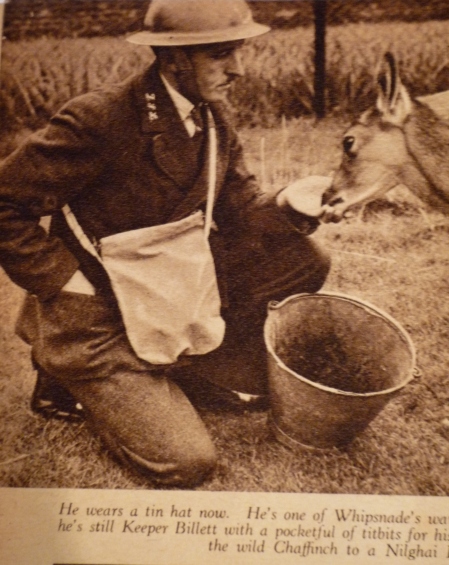
Primary history source material – Keeper Billett of Whipsnade Zoo ZSL in tin hat and gas mask pictured in the shortlived ‘Animal And Zoo magazine’, November 1939 (magazine / photo from the World War Zoo archive, Newquay Zoo)
Sound is an important part of the workshop ranging from learning the meaning of the sharp blasts of my ARP whistle to the different sound of air raid sirens – warning and all clear – keyed in from sound effects, as the real hand-cranked sirens are deafening in small spaces and we don’t want to accidentally evacuate the zoo. The gas warning rattle, beloved of football crowds in the past, is a popular and noisy thing to try at the workshop’s end.
Apart from looking at the display and trying on some of the headgear, another popular activity at the end of a workshop is a quick demonstration outside of ‘fire bomb drill’ that older children and zoo families would have learnt on firewatch or fire guard duty using our battered leaky but still working original stirrup pumps. Young arms soon tire from pumping these and thankfully there’s no fire involved but it’s a chance to soak your friends! Many gardeners made use of civil defence ‘war surplus’ stirrup pumps after the war as handy garden sprayers.
If we’re in luck, one of our older zoo volunteers pops in to answer questions about wartime childhood and even bring in their original ration books and identity cards. Sometimes our volunteers and our staff (including me!) dress up as characters using original and replica uniforms showing jobs that zoo staff would have done, often after a day’s work ranging from Fire Watch, Fire Service, Air Raid Precautions or Home Guard. There are a few of my family photographs of air raid shelters, harvest and garden work and stories from my evacuee parents that I retell in the talk too!
Wartime gardening and schools gardening
In summer we finish off our wartime zoo schools workshops with making of newspaper pots and potting up of sunflower seeds (good source of animal food in wartime and very wildlife friendly today) for students to take home. It’s good to hear from children and teachers that school gardens are thriving again as part of Growing Schools Gardens, one practical follow-up to the ‘Dig For Victory’ history topic and zoo visit.
There is an excellent RHS / IWM Dig For Victory schools pack available online as a pdf It’s good to see this growing area of the Learning Outside the Classroom manifesto and network, something which we’re proudly part of at Newquay Zoo as an accredited or quality learning venue since 2009.
Now that World War Two is staying in modified form in the new ‘Gove’ 2014 primary school history national curriculum, we look forward to running many more schools WW2 workshops about this remarkable period in zoo and botanic garden history. I’m sure many teachers have enjoyed teaching the old Home Front primary history curriculum elements and will adapt elements from units like the evacuees.
Each workshop throws up interesting new questions to answer or investigate. “What happened in zoos and associated botanic gardens in World War 1?” is one recent question we’ve been asked and are looking at, ahead of the 1914 centenary. We’ve already blogposted about the war memorials at Kew Gardens and London Zoo – see previous posts. We will be researching a WW1 version of the workshop in 2015.
The next big job is editing some of our research and collection of wartime diaries or letters into a resource pack or blog entries, something we’re working on throughout the next few years. Some of our North-East wartime farmer’s diaries are on loan to Beamish museum for their new Wartime Farm.
We also run similar history sessions for secondary schools at Newquay Zoo and our sister Zoo Paignton Zoo in Devon. Herbert Whitley’s Paignton Zoo was operational in wartime as a camp site for D-Day US troops and had some strange wartime tales. Paignton also hosted evacuee staff and animals from the bombed and blitzed Chessington Zoo.
You can find out more about the World War Zoo Gardens project, schools workshops and local offsite talks and our contact details on our schools webpage
—————————————————————————————————————————————–
Wartime Savoury Potato Biscuit recipe
Sometimes cooked up to be served on World War Zoo Gardens workshop days (Please note: wartime biscuits not always available in workshops).
* N.B. Leave out cheese if you have dairy allergy, the pepper is enough to make the taste ‘interesting’.
Adapted from the original Recipe from Potatoes: Ministry of Food wartime leaflet No. 17
Makes about 24 approx 3 inch biscuits
Ingredients
2 ounces margarine
3 ounces plain flour
3 ounces cooked mashed potato
6 tablespoons grated cheese*
1.5 teaspoons table salt
Pinch of cayenne or black pepper
Cooking instructions
1. Rub margarine into flour
2. Add potato, salt, pepper (and cheese if using*)
3. Work to a stiff dough
4. Roll out thinly and cut into shapes
5. Bake in a moderate oven, 15 to 20 minutes.
Tags: Blitz, dig for victory garden, history teaching, Inspire Curriculum, Newquay Zoo, Paignton Zoo, primary history teaching, wartime gardening, world war 2, WW1, WW2, WW2 schools workshops, Year 6 History, zoo
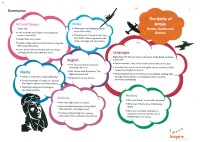


April 19, 2015 at 11:04 am |
[…] you can eat”, that fits with our World War Zoo Gardens allotment philosophy and workshop approach at Newquay […]
LikeLike
September 7, 2015 at 1:57 pm |
[…] https://worldwarzoogardener1939.wordpress.com/2014/01/29/world-war-zoo-gardens-workshops-for-schools… […]
LikeLike
March 10, 2016 at 10:17 pm |
[…] https://worldwarzoogardener1939.wordpress.com/2014/01/29/world-war-zoo-gardens-workshops-for-schools… […]
LikeLike